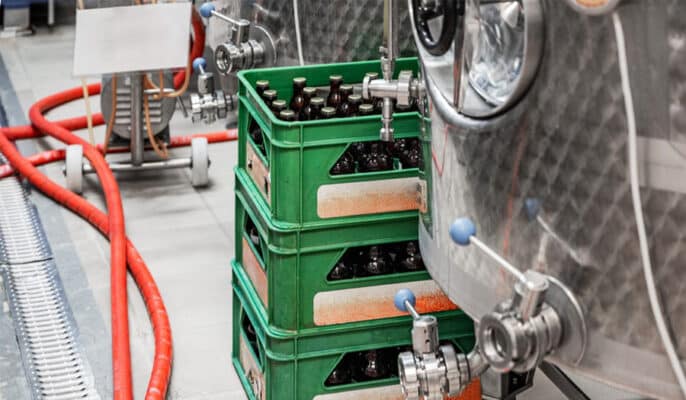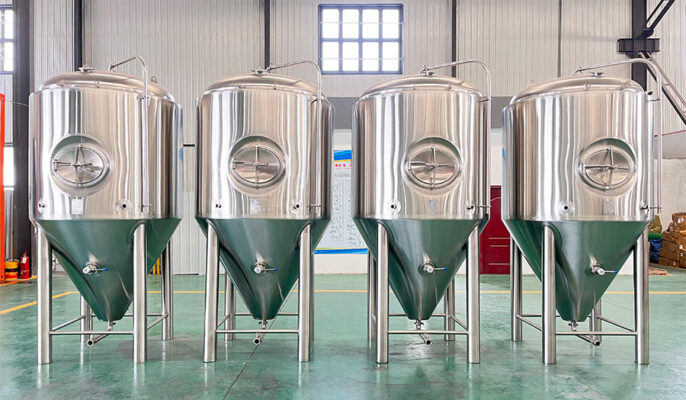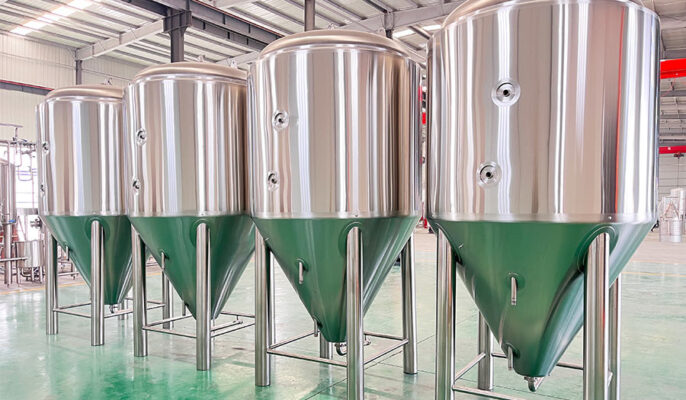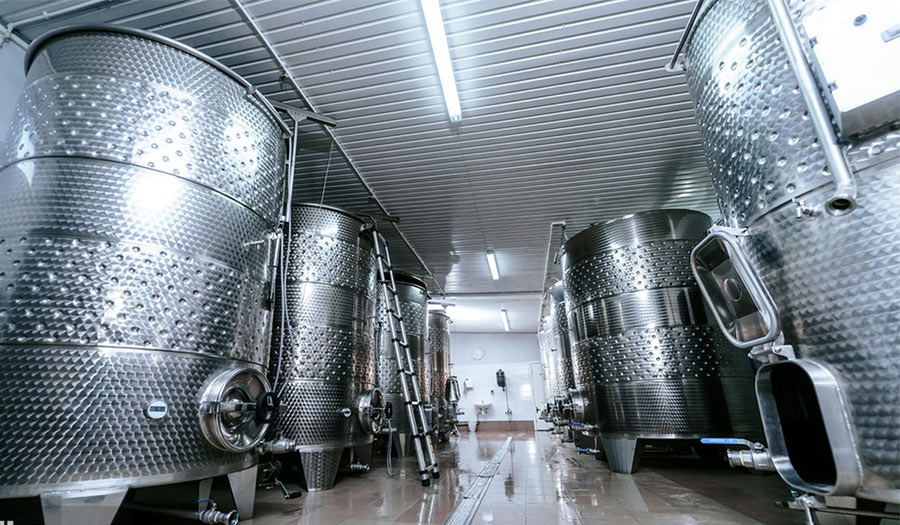맥주 양조에서 발효는 최종 제품의 품질을 결정하는 핵심 고리이며, 올바른 발효제를 선택하는 것은 발효 용기 를 선택하는 것이 훨씬 더 중요합니다. 다양한 유형의 용기는 재료, 모양, 기능 면에서 장점이 있으며, 이는 효모의 성능, 알코올 생산량, 풍미의 복잡성에 직접적인 영향을 미칩니다. 이러한 용기의 특성을 깊이 이해함으로써 양조자는 자신의 필요와 기술 수준에 따라 가장 적합한 발효 도구를 선택하여 고품질의 맥주를 양조할 수 있습니다.
발효의 개념
발효는 미생물의 작용으로 당분이 알코올과 이산화탄소로 전환되는 과정을 말합니다. 이 과정에서 효모는 가장 중요한 역할을 합니다. 효모는 당분을 알코올로 전환할 뿐만 아니라 맥주의 맛, 향, 풍미에도 영향을 미칩니다. 따라서 적합한 발효 용기를 선택하는 것이 중요합니다.
무엇인가요? 발효 용기?
발효 용기는 다양한 음료의 발효 과정을 담고 촉진하는 데 사용되는 용기입니다. 발효 과정에서 효모나 박테리아는 당분을 소비하고 음료의 종류에 따라 알코올이나 산으로 전환합니다. 올바른 용기는 발효 과정에 영향을 미치므로 제품의 최종 맛과 품질에 영향을 미칩니다.
발효 과정에서 용기는 다음과 같은 기본 요구 사항을 충족해야 합니다:
- 밀봉: 과도한 압력을 피하기 위해 이산화탄소는 배출하면서 산소와 오염 물질은 유입되지 않도록 차단합니다.
- 재질: 일반적인 재료로는 스테인리스 스틸, 유리, 플라스틱, 목재 등이 있습니다. 각 재료는 와인의 풍미와 안정성에 서로 다른 영향을 미칩니다.
- 온도 조절: 용기의 디자인은 효모가 최적의 온도에서 발효되어 이상적인 풍미와 알코올 농도를 얻을 수 있도록 온도 조절을 지원해야 합니다.
- 손쉬운 세척: 발효 용기는 잔여물과 박테리아가 발효 품질에 영향을 미치지 않도록 세척과 소독이 쉬워야 합니다.

발효 용기의 주요 유형
스테인리스 스틸 발효 탱크
스테인리스 스틸 발효 탱크는 가정용 양조장과 상업용 양조장에서 많이 사용하는 제품입니다. 내구성이 뛰어나고 세척이 쉬우며 온도 조절 기능이 뛰어납니다. 이러한 용기는 산소 침입을 방지하고 발효 과정의 일관성을 보장합니다.
- 장점: 세척 및 유지 관리가 쉽고, 고온과 고압을 견딜 수 있어 대규모 양조에 적합합니다.
- 단점: 가격이 높다는 것은 초기 투자 비용이 더 크다는 것을 의미합니다.
플라스틱 발효 탱크
플라스틱 발효 탱크는 가볍고 저렴합니다. 플라스틱 발효 탱크는 초보자나 예산이 부족한 분들에게 이상적입니다. 그러나 플라스틱 발효 탱크는 다른 재료와 동일한 수준의 단열 및 빛 보호 기능을 제공하지 못할 수 있습니다.
- 장점: 이동과 청소가 간편하고 투명한 디자인으로 발효 과정을 쉽게 관찰할 수 있습니다.
- 단점: 장기간 사용하면 냄새가 흡수될 수 있으며 식품 등급 플라스틱을 선택해야 합니다.
유리병 발효 용기
유리 주전자는 홈브루어들이 가장 많이 사용하는 제품으로, 그 아름다움과 맛의 온전함을 유지하는 능력으로 높은 평가를 받고 있습니다. 하지만 무겁고 깨지기 쉬우므로 조심해서 다뤄야 합니다.
- 장점: 액체와 반응하기 쉽지 않고, 밀폐성이 좋으며, 투명하여 관찰이 용이합니다.
- 단점: 깨지기 쉽고, 용량이 제한적이며, 소량 양조에 적합합니다.
배럴
배럴은 증류주, 와인, 신맥주를 숙성하는 데 자주 사용됩니다. 배럴은 음료에 독특한 풍미를 부여하여 복잡함과 개성을 더합니다. 하지만 정기적인 관리가 필요하고 비용이 많이 듭니다.
- 장점: 맥주에 독특한 풍미를 더할 수 있으며 장기 보관에 적합합니다.
- 단점: 정기적인 유지 관리가 필요하고 미생물 오염에 취약합니다.
발효 용기는 어떻게 사용하나요?
발효 용기를 사용하는 과정에는 원활한 발효와 고품질 와인을 보장하기 위한 몇 가지 주요 단계가 포함됩니다. 다음은 발효 용기를 사용하기 위한 몇 가지 주요 단계입니다:
- 세척 및 소독: 사용하기 전에 용기와 액세서리를 깨끗이 세척하고 적절한 소독제로 소독하여 오염을 방지하세요.
- 원재료를 추가합니다: 맥아, 설탕, 이스트, 물 등의 원재료를 레시피에 따라 발효 용기에 붓고 골고루 저어줍니다.
- 온도 조절하기: 발효 용기가 효모의 활동을 지원하는 적절한 온도 범위에 있는지 확인하세요. 맥주 종류에 따라 필요한 온도가 다릅니다.
- 밀폐된 용기: 밀봉 뚜껑과 공기 밸브를 사용하여 가스는 빠져나갈 수 있지만 오염을 방지하기 위해 외부 공기가 들어가지 않도록 용기를 밀봉합니다.
- 모니터링: 거품, 기포 발생, 온도 변화 등 발효 상태를 정기적으로 확인하여 발효가 정상적으로 진행되고 있는지 확인합니다.
- 2차 발효: 1차 발효가 끝난 후 2차 발효가 필요한 경우 맥주를 다른 용기에 옮겨 침전물과 불순물을 제거할 수 있습니다.
- 세척 및 관리: 발효가 끝나면 잔여물이 다음 사용에 영향을 미치지 않도록 용기를 제때 세척하세요.

발효 용기를 선택할 때 고려해야 할 요소는 무엇인가요?
크기 및 용량
발효 용기를 선택할 때는 용기의 크기가 양조하는 배치 크기와 일치해야 합니다. 발효 과정에서 생성되는 거품과 가스를 담을 수 있는 충분한 여유 공간이 용기에 있는지 확인하고 넘침을 방지하세요. 동시에 적절한 크기는 발효 효율을 개선하고 효모가 최상의 환경에서 활동할 수 있도록 도와줍니다.
소재 및 내구성
재료마다 장단점이 있으므로 용기를 선택할 때는 내구성, 단열성, 음료 맛에 미치는 영향 등을 충분히 고려해야 합니다. 예를 들어 스테인리스 스틸 용기는 부식에 강하고 세척이 쉬워 대량 양조에 적합하며, 유리 용기는 맛에 미치는 영향은 적지만 깨지기 쉽습니다. 각 재료의 특성을 이해하면 정보에 입각한 선택을 하는 데 도움이 될 수 있습니다.
온도 제어
발효 온도는 효모의 활동과 맥주의 풍미에 결정적인 영향을 미칩니다. 일부 발효 용기에는 온도 조절 기능이 내장되어 있어 다양한 종류의 맥주에 맞게 정밀하게 조절할 수 있습니다. 다른 발효 용기는 적절한 발효 온도를 유지하기 위해 냉각 재킷이나 온도 제어 시스템과 같은 추가 장비가 필요할 수 있습니다. 올바른 온도 제어 장비를 선택하면 양조 결과를 크게 개선할 수 있습니다.
청소 및 소독
발효 용기의 디자인은 내부에 쉽게 접근할 수 있어야 하며, 이는 철저한 세척과 소독에 매우 중요합니다. 발효 용기의 입구가 청소 도구를 쉽게 사용할 수 있고 잔여물과 박테리아가 번식하지 않도록 충분히 큰지 확인하세요. 동시에 용기는 분해와 조립이 쉬워 매일 유지보수가 용이하고 최적의 위생 조건에서 사용할 때마다 최종 제품의 품질을 향상시킬 수 있어야 합니다.
발효 용기 크기 선택
- 소형 용기: 가정용 양조 및 실험용 양조에 적합하며, 보통 5-50리터 사이입니다. 작은 용기는 이동과 세척이 용이하여 초보자에게 적합합니다.
- 중형 용기: 보통 50-1000리터 사이의 중소규모 양조에 적합합니다. 이 용기는 가족 모임이나 소규모 비즈니스의 요구를 충족할 수 있습니다.
- 대형 용기: 일반적으로 상업용 양조에 사용되며, 보통 500리터 이상입니다. 대량 생산이 가능하지만 전문 장비와 기술 지원이 필요합니다.

자주 묻는 질문
맥주 발효에 가장 적합한 용기는 어떤 종류인가요?
맥주 발효에 가장 적합한 용기는 일반적으로 온도와 압력을 제어하면서 산소와 오염 물질의 유입을 효과적으로 차단하는 밀폐형 스테인리스 스틸 발효기입니다.
컨테이너의 크기는 어떻게 선택해야 하나요?
용기의 크기는 배치의 크기와 일치해야 하며, 발효 과정에서 생성된 거품이 넘치지 않도록 충분한 헤드 스페이스를 확보해야 합니다.
발효 온도는 어떻게 조절하나요?
일부 발효 용기에는 온도 제어 시스템이 내장되어 있는 반면, 다른 용기에는 최적의 발효 환경을 유지하기 위해 온도를 조절하기 위한 추가 장비(예: 냉각 재킷)가 필요할 수 있습니다.
발효 용기를 세척하는 가장 좋은 방법은 무엇인가요?
무향 세제와 뜨거운 물로 용기를 깨끗이 씻은 다음 적절한 소독제로 소독하여 사용 전후에 위생적으로 관리하세요.




